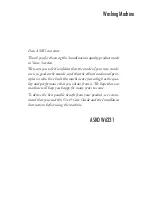
Use
39
EN
White wines
White wines are generally more acidic than
reds and contain less tannin. To be enjoyed
at its best, an acidic drink should usually be
stored at a slightly lower temperature than
other types, and so these wines should be
stored at a temperature between 10°C
and 14°C.
Young, fresh, aromatic white wines can be
served at a temperature as low as 10°C,
while for less aromatic wines 12°C is
recommended. For full, mature white wines
which have aged in the bottle for a few
years, higher temperatures are acceptable
and they can be served at between 12°C
and 14°C.
Serving a white wine at a higher
temperature means emphasising its “sweet”
properties, while the acidity and sharpness
considered pleasant and desirable in wines
of this kind will be less noticeable.
Rosé wines
Generally, the rules for serving rosé wines
are the same as for whites. However, it is
important to consider these wines' tannin
content and serve them at a higher
temperature if necessary so that their flavour
is not too sharp. Tannin content permitting,
young, fresh rosé wines are served
between 10°C and 12°C, while more
robust, full-bodied types, including more
mature wines, can be served between
12°C and 14°C.
Red wines
The serving temperature for red wines
depends on a great deal of factors, but in
view of their higher tannin and lower acidity
than whites, they are usually served at
higher temperatures. Young red wines with
low tannin are usually served between 14°
and 16°C, while for more full-bodied types
16°C or in exceptional cases even 18°C
may be recommended.
Young red wines with low tannin and a
fairly uncomplicated structure can be
served at between 12°C and 14°C
without tasting too sharp, and will still be
very pleasant. This rule applies to
“nouveau” wines, made by a special
method which reduces their tannin content;
they can be appreciated to the full at cooler
temperatures than other red wines.








































